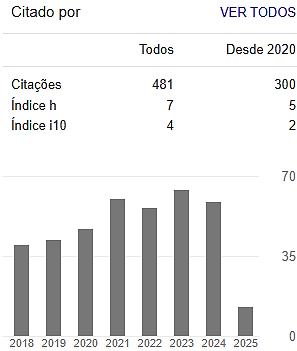REMOÇÃO DE CORANTES TÊXTEIS POR COAGULAÇÃO-FLOCULAÇÃO-SEDIMENTAÇÃO E ADSORÇÃO.
Palavras-chave:
Ftalocianina de Cobre; Carvão ativado; Zeólita; Índice de azul de metileno.Resumo
Os efluentes têxteis quando lançados nos corpos hídricos sem o tratamento adequado provocam prejuízos a qualidade da água dos corpos receptores, devido, a grande quantidade de corantes utilizados para o tingimento dos tecidos, sendo necessária a realização de pesquisas visando melhorar a eficiência do tratamento destes efluentes. O objetivo do trabalho é avaliar a remoção da dispersão pigmentária de Ftalocianina de cobre em escala de bancada. Para isso, foi preparado um efluente sintético com dispersão pigmentária de Ftalocianina de cobre, e os tratamentos utilizados foram coagulação-floculação e sedimentação, utilizando Hidroxicloreto de Polialumínio como coagulante, seguido de adsorção em leito fixo. A eficiência do tratamento foi avaliada pelos parâmetros pH, condutividade, turbidez e concentração residual de pigmento. Os resultados indicaram a melhor condição de coagulação com pH de 7,41, e dosagem de 10 mg.L-1 de coagulante resultando em remoções de 95,0% da turbidez e 90,0% de cor. O melhor adsorvente amostrado neste trabalho apresentou Índice de Azul de Metileno de 328,12 mg.g-1 e Qe útil para adsorção da dispersão pigmentária de 44,57 mg g-1. O tratamento por coagulação-floculação e sedimentação foi capaz de remover 75,2% dos pigmentos e com o pós tratamento por adsorção a remoção dos pigmentos chegou a 97,3%.
Downloads
Referências
APHA, AWWA, WEF. Standard Methods for the Examination of Water e Wastewater, 22ª ed. Washington. D. C., 2012.
BRASIL, Ministério do Meio Ambiente. Conselho Nacional de Meio Ambiente. Resolução N° 357, 17 de março de 2005. Dispõe sobre a classificação dos corpos de água e diretrizes ambientais para o seu enquadramento, bem como estabelece as condições e padrões de lançamento de efluentes, e dá outras providências. Brasília, 2005.
BRASIL, Ministério do Meio Ambiente. Conselho Nacional do Meio Ambiente. Resolução N° 430 de 13 de maio de 2011. Complementa e altera a Resolução no 357 de 2005, Brasília, 2011.
CARVALHO, T. E. M. FUNGARO, D. A. IZIDORO, J. C. Adsorção do corante reativo laranja 16 de soluções aquosas por zeólita sintética. Química Nova, v. 33, N. 2, p. 358-363, 2010.
CRINI, G. BADOT, P.M. Application of Chitosan, a Natural Aminopolysaccharide, for Dye Removal from Aqueous Solutions by Adsorption Processes Using Batch Studies: A Review of Recent Literature. Progress in Polymer Science, v. 33, p. 399-447, 2008.
DOTTO, G. L. VIEIRA, M. L. G. GONÇAVES, J. O. e PINTO, L. A. A. Remoção dos corantes azul brilhante, amarelo crepúsculo e amarelo tartrazina de soluções aquosas utilizando carvão ativado, terra ativada, terra diatomácea, quitina e quitosana: estudos de equilíbrio e termodinâmica. Química Nova, v. 34, N. 7, p. 1193-1199, 2011.
FOUST, A.S.; WENZEL, L.A.; CLUMP, C.W. Princípio das operações unitárias. Rio de Janeiro: Guanabara Dois, 1982.
FUKUMOTO, A. A. F.; KURODA, E. K. Seleção de carvões ativados para adsorção de microcistinas. Eng. Sanit. Ambient. v. 24, n. 2, p. 295-304, 2019.
GOMES, M. S. S. 0; NASCIMENTO, J. R.; SILVA, M. G. O. mesocarpo de babaçu (ORBINYA SP) como adsorvente do dodecil benzeno sulfonato de sódio (SDBS). Holos. v. 7, n. 32, p. 51-61, 2016.
GUARATINI, C. C. I.; ZANONI, M. V. B. Corantes têxteis. Química Nova, v. 23, p. 71-78, 2000.
HOLANDA, C. A. SOUZA, J. L. SANTOS, C. C. SILVA, H. A. S. ABREU SANTANA, S. A. A. S. COSTA, M. C. P. SCHULTZ, M. S. BEZERRA, C. W. B. Remoção do Corante Têxtil Turquesa de Remazol Empregando Aguapé (Eichhornia crassipes) como Adsorvente. Orbital: The Electronic Journal of Chemistry. v. 7, n. 2, p. 141-154, 2015.
JAPÃO, Japanese Industrial Standar – JIS. K 1474 – Test methods for activated carbon. 2014.
JIMENEZ, R. S.; BOSCO, S. M. D.; CARVALHO, W. A. remoção de metais pesados de efluentes aquosos pela zeólita natural escolecita – influência da temperatura e do ph na adsorção em sistemas monoelementares. Química Nova, v. 27, n. 5, p. 734-738, 2004.
KUNZ, A.; ZAMORA, P. P.; MORAIS, S. G.; DURÁN, N. Novas tendências no tratamento de efluentes têxteis. Química Nova, v. 25, n. 1, p. 78-82, 2002.
LEDAKOWICZ, S.; SOLECKA, M.; ZYLLA, R. Biodegradation, decolonization and
detoxification of textile wastewater enhanced by advanced oxidation processes. Journal of Biotechnology, v. 89, p. 175-184, 2001.
LOPES, C. S. D. Análise ambiental da fase de acabamento do jeans. Revista de Saúde, Meio Ambiente e sustentabilidade, v. 6, p. 42-46, 2011.
MACHADO, M. C.; VARGAS, R. R.; SILVA, M. A.; ENGELS, T. Uso de sementes de Moringa Oleífera (LAM) no tratamento de efluente têxtil. Revista Principia, vol. 33, p. 37-49, 2017.
MÜLLER, C. C.; RAYA-RODRIGUEZ, M. T.; AND CYBIS, L.F. Adsorção em carvão ativado em pó para remoção de microcistina de água de abastecimento público. Eng Sanit Ambient, vol. 14, No. 1, p. 29-38, 2009.
PIVA, J. A. L. D., SANTOS, O. ANDRADE, C. M. G. Determinação e análise de isotermas de adsorção do corante azul 5G em leito fixo de carvão ativado. Departamento de Engenharia Química, v. 33, n. 4, p. 435-438, 2011.
SILVA, E. S. C. A.; PINTO, B. C.; LIMA, A. S.; OLIVEIRA, M. A.; BEZERRA, A. C. S.; SOUZA, T. S. F.; RODRIGUES, C.G; MACHADO, A. R. T. Equilíbrio de adsorção do corante rodamina B em carvão ativado obtido dos resíduos do coco verde. The Journal of Engineering and Exact Sciences, v. 03, N.8, p. 1051-1058, 2017.
VASQUES, A.R. SOUZA, S. M. A. G. U. WEISSENBERG, L. SOUZA, A. A. U. VALLE, J. A. B. Adsorção dos corantes RO16, RR2 e RR141 utilizando lodo residual da indústria têxtil. Eng Sanit Ambient, v. 16, N. 3, p.245-252, 2011.

